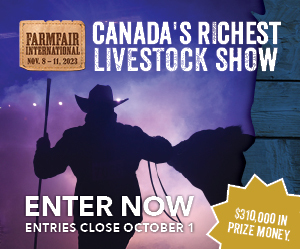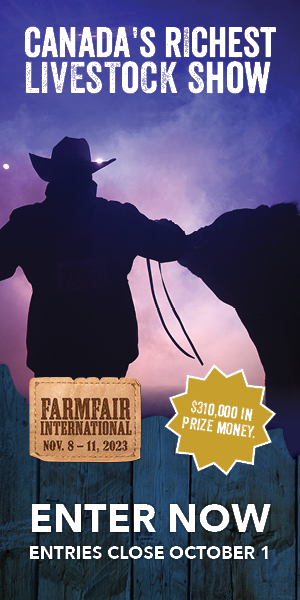AB Direct - Steers
Rail: ---
AB Direct - Heifers
Rail: ---
US Trade- Steers
Rail: 290.00 (IA)
US Trade - Heifers
Rail: 290.00 (IA)
Canadian Dollar
0.02
Out and About with Alberta Beef Producers | Fall run begins with optimism
As the leaves begin to change and the weather starts to shift, producers remain optimistic as prices stay at record-breaking highs. With that said, there has been a rising concern on the duration of the shockingly high prices, and what it means for our industry here at home.
Having some similar concerns regarding my own operation, I approached our local Fieldman Leo Leblanc from North Central Livestock in Clyde, Alberta for some insight on what the fall markets may bring.
“These are record-high prices. We are seeing about a 20-40 per cent increase in prices across the board, that’s probably pretty accurate,” he told me. “I would say that cows are about 20-25 per cent higher, and feeder calves are more at about 40 per cent more than last year.
“Feeder prices are going to remain strong. We’re short on replacement stock, and the cow herd numbers are down. There is enough demand and enough areas with feed that can background or finish these calves and carry them into the new year. It will be interesting to see what happens because these cattle are so high. 1,000-lb open heifers are going for $2.80/lb. If you have cull cows and/or bulls, it’s time to sell them now before [prices] go down, because these are crazy good prices, and they are not going stay this high.”
These truly are incredible prices, which Alberta hasn’t seen in the beef industry in seven to eight years and not nearly to this magnitude. There are a few factors that led to this much-needed increase in cattle prices.
Travis Olson of Olson Ranches, a purebred Angus breeder in Athabasca, Alberta also shows some optimism going forward as he plans out his strategy going into fall.
“The dollar dropping on us has been good, and the U.S corn yield being strong has helped to keep the cost of finishing fat cattle down, making the return on the fat cattle phenomenal,” he says. “It’s kind of the perfect storm. The other thing is that people are still buying a lot of hamburger and steaks. When they were locked up and couldn’t go out and dine, or go out on vacation, they were deprived of that for almost two years so now they want to go out and enjoy. The demand for our product is still high.”
Even though prices are record high, producers may face some tax challenges when it comes to selling or purchasing stock this fall. But larger or mixed operations may have the means to avoid the high taxes that will come in tow, if they choose to sell.
“When you start seeing 700-lb calves coming off the cow bringing $3.40/lb-$3.50/lb ($2,500-$2,600 for calves off the cow), this will allow producers to have the opportunity to reinvest back into the herd, whether they retain more replacement heifers or purchase more bred stock,” says Leblanc.
What we could see going forward is fewer of the smaller cow-calf operations and more grasser/feeder operations, as fewer producers will focus on re-building or maintaining the herd that they would have to care for over the winter months. This will also give them the option to purchase cattle that could be released on grass. If feed isn’t a concern, producers may find themselves purchasing bred stock to calve out and sell at a strong price as pairs in the spring.
“There will be a premium on good, young, bred stock this fall,” says Leblanc. “This will make breeding stock a hot commodity this fall bringing in a high premium for cows and bred heifers.”
Both Olson and Leblanc believe that prices are to look promising going forward, making it justifiable to spend a little more on bred stock when calves continue to sell high, or to retain a few more heifers if you have the feed available.
If we can endure a warm and lengthy fall and allow cattle to continue to graze into the better part of October, it will allow the auction markets to place the cattle efficiently. If there are no pressures of time limitations, Leblanc remains optimistic that the markets will remain strong this fall.
There will be some areas of the province that will be tight for not only feed but water supply before the winter months hit. ABP is currently in the process of working with the provincial government on support programs that will be available for beef producers that may find themselves in that type of position.
Auction Mart Tours
Alberta Beef Producers had the opportunity to visit a few locations in the northern part of the province starting with North Central Livestock (Clyde), Vold, Jones & Vold (Westlock), Dryland Cattle Trading Co. (Veteran) and Provost Livestock Exchange (Provost). Come and join me and some of our delegates at a sale near you:
Fall Schedule
Vold, Jones & Vold
Beaverlodge, AB
September 28, 2023, 9:00 a.m.
Southern Alberta Livestock Exchange
Fort Macleod, AB
October 10, 2023, 9:00 a.m.
Balog Auction Mart
Lethbridge, AB
October 11, 2023, 10:30 a.m.
Perlich Bros. Auction Market
Lethbridge, AB
October 12, 2023, 10:00 a.m.
Foothills Auctioneers Inc
Stavely, AB
October 16, 2023, 11:00 a.m.
Picture Butte Auction
Picture Butte, AB
October 24, 2023, 10:30 a.m.
Viking Auction Mart
Viking, AB
October 31, 2023, 9:00 a.m.
Vermilion Livestock Exchange
Vermilion, AB
November 1, 2023, 9:00 a.m.
Thorsby Stockyards
Thorsby, AB
November 6, 2023, 9:00 a.m.
Vold, Jones & Vold
Rimbey, AB
November 7, 2023, 9:00 a.m.
Vold, Jones & Vold
Ponoka, AB
November 8, 2023, 9:00 a.m.
Stettler Auction Mart
Stettler, AB
November 14, 2023, 10:00 a.m.
Innisfail Auction Mart
Innisfail, AB
November 15, 2023, 9:00 a.m.
Olds Auction Mart
Olds, AB
November 21, 2023, 9:00 a.m.
Calgary Stockyards
Strathmore, AB
December 7, 2023, 9:00 a.m.
Medicine Hat Feeding Co.
Medicine Hat, AB
December 14, 2023, 1:00 p.m.
Bow Slope Shipping Association
Brooks, AB
December 15, 2023, 9:00 a.m.
This article was first published in Volume 3 Issue 3 of ABP Magazine (September 2023). Watch for more digital content from the magazine on ABP Daily.
Leave a Comment
Add abpdaily.com to your home screen
Tap the menu button next to the address bar or at the bottom of your browser.
Select ‘Install’ or ‘Add to Homescreen’ to stay connected.



Share this article on
About the Author
Taylor is Alberta Beef Producers' Marketing and Communications Assistant. She comes from a mixed grain and cattle operation by Lamont, AB, where she continues to raise purebred Angus and commercial cattle with her parents in her spare time. Taylor studied Animal Science Technology and Agribusiness at Lakeland College. With a strong background in livestock marketing and agricultural event planning, she is actively involved within the agricultural community and will be a familiar face from ABP at upcoming events.